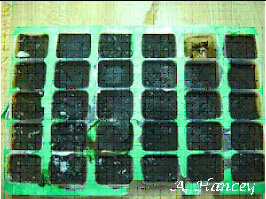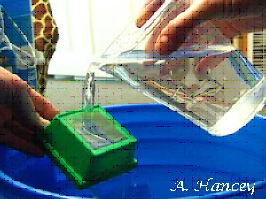Last updated: 2/18/2009
Written by A. Hancey
Table of Contents
Introduction
Hi, my name is Amie and I have raised rotifers for approximately 3.5 years and copepods for over 2 years. The method used is fairly common for raising copepods (with a few exceptions), but certainly not at all common for raising rotifers and you may not find another document on the internet talking about raising rotifers using this method. I have had plenty of people question me about raising rotifers this way instead of the most common way - in a 10 gallon glass aquarium with lights and a heater. The reason I have adopted this method is pretty simple, it works, it’s very low-maintenance and I haven’t had a rotifer crash for over a year and a half (knock on wood). I can’t even count the number of cultures I lost using the common method or raising rotifers. Not only is it expensive to lose a culture but very frustrating to have to start over. It’s important that you follow these instructions closely. If you do it any other way, it just doesn’t work. Don’t make this harder than it is..it’s really, really easy! I hesitate to use the term tigger-pod™ because that is actually a copyrighted name given to the copepod Tigriopus californicus. However, when I mention copepods or pods, I have only tried this method on the tigriopus californicus species, so I cannot guarantee that it will work on other copepods. Since the tigriopus californicus is a Calanoid copepod, there is good probability that this method will work on other Calanoid copepods.
What you need
1) 5+ gallon dark colored bucket. A white bucket will work but they will grow at a significantly slower rate.
2) A small air pump, an airline hose, an air valve and about 8-12” of rigid airline tubing (found at our Equipment & Supplies section under "Shop Now").
The reason I use a piece of rigid tubing at the end of the airline is for convenience. Sometimes it’s necessary to clean the tubing and it is a lot easier to replace and clean the rigid tubing than it is to clean the airline.
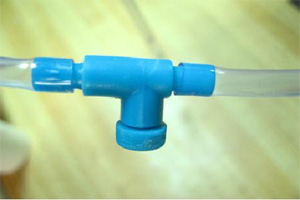
Airline Value used to adjust air flow
3) I use newly made salt water at 1.019-1.020ish. Actually, I’ve talked to a couple of people and they are finding that tank water, after a water change, is working just fine .. but I’m still using new SW.4) Glycerin-free Nannochloropsis phytopaste.
Why glycerin-free? Glycerin is a cryopreservative that is added to most algae pastes that you buy on the market. It prevents the paste from freezing during storage. I have used several different types of phytopastes and when I first receive a new paste, I always do 2 things, 1) look under the microscope for live cells, and 2) try to grow a culture of phytoplankton from the paste. With glycerin-free paste, I have always found live phytoplankton under the microscope and I have always been able to start a culture of live phytoplankton from it. With glycerin phytopaste, I sometimes see a few live cells of phytoplankton, but significantly less than with the glycerin-free. I had very little success trying to start a culture with glycerin paste.
What does this mean? I don’t know..sorry. But, my best guess and from some research I have done on cryopreservative glycerin on the internet, the glycerin actually kills about 40-50% of the cells it comes in contact with. When I have fed a glycerin paste to my cultures, I would have to change the water more often because of high ammonia levels or contamination. I lost a lot of cultures before switching to glycerin-free paste and I’m just going to say that it’s because the paste is more ‘alive’ without the glycerin. How is that for a scientific explanation (just don’t quote me on that)?
5) Ambient Light – You will need to place the bucket in a room where there is light in the room for about 12 hours. It can come from another tank or whatever. You don’t want to have it directly over the bucket though.
6) Plastic ‘tray’ from frozen food – This one is strange but it is important. You need one or 2 of those trays that has cubed frozen food when you buy frozen brine, mysis, etc. If you don’t know what I’m talking about, see the picture on the next page.
7) A 53 micron sieve if you are raising rotifers and a 180 and 300 micron sieve for copepods. I have expanded on this subject in Appendix B at the end of this document. Plus, I have given references of where to get good sieves or to buy micron material so you can make your own.
8) A bright flashlight – Use this to shine down into the bucket. It’s the best way to see how concentrated the culture is getting and whether new food is needed.
Getting Set Up
When you buy your paste, it should be frozen. Put the bottle in the refrigerator for a day to thaw and then pour the entire bottle into empty cube trays and put the trays in the freezer for 24 hours. Basically, you are making small phyto cubes. The reason for this is simple, if you keep the phyto bottle in your refrigerator, it will go bad in about a month, but it lasts for 3 months in the freezer. If you freeze it, you will have to thaw the entire bottle every time you want to use it. If, by some accident, you leave it sitting out over night, the phyto will go rancid and kill your culture. The phytocubes are the best method I have found the save time and money.
Once frozen, you can pop them out and put them in a ziplock bag. If you just put the tray in a ziplock back instead of popping them all out at the beginning, they will be harder to take out later. Don’t ask me why, but they are easier to get out after first frozen.
Frozen 'PhytoCubes'
Preparing a BucketFind a good location for your bucket to reside. This will be an out of the way spot that is partially under a shelf but will receive light from a window or other aquarium during the day. You might want to set the bucket up on a 1 foot tall stool if you have one - this will help when siphoning later. Also, if possible, a basement is best…the cooler the better. I have mine in an unfinished part of my basement that doesn’t have any windows so it doesn’t get heat in the summer.
Now add 1 gallon of mixed saltwater at 1.019ish. I say ‘ish’, because I’m pretty bad at measuring. I usually make my saltwater anywhere from 1.018-1.021, but I don’t top-off that much, so I’m not sure it matters that much.
It’s never a bad idea to let your new rotifers/copepods float in the new bucket for 10 minutes to make sure there isn’t a temperature shock. (I’ve never done this, but I’m sure it’s not a bad idea.) Then, dump the critters into the bucket.
Note: If you have received a sample of pods from me then they have been setup and ready to go into a 1 gallon setup. The sample is different from a regular bottle that you buy because I’ve already added enough phytopaste to feed them for several days while you are waiting to receive your paste in the mail.
Take a single cube of phytopaste from the freezer and let it thaw in about 1 cup (250 cc) of saltwater. Stir it well, and pour in enough of the ‘green water’ to make the water a medium green color. I know, this is hard to know exactly how much to put in. But you don’t want to be able to see the bottom of the bucket. I use the airline hose to stir the water around a little bit, and then add a little more. If you get too much in, don’t worry about it, they will eat it. If you are worried you got too much, add more salt water. If you don’t think you got enough in, watch and see how fast the water clears as they eat it and add more. You will get the hang of it, I promise. My general rule, if I can see the bottom of the bucket, they need more food.
If you have any of the ‘phytowater’ left in the cup, cover it with saran wrap or put it in a Tupperware container and put it in the refrigerator and save it for next time. Mark it so no one drinks it…blah.
This is a little tricky to explain. I don’t add a lot of air to the bucket. You don’t want them tossing and turning. I just let the rigid airline tubing go down a few inches into the bucket and then adjust it to bubble about 2 bubbles per second.
If you are reading this article for growing copepods, then I usually take the air completely out every other day. I will grow 2 cultures of copepods side-by-side and I’ll have one line of air. I’ll just move the airline from one bucket to the other every couple of days. I’ve found that I get a lot larger population when I do this. I have grown these in a glass container and have found that the newborn babies cling to the edges of the container. If the air is too strong, you will not see an increase in population and I think it’s related to this somehow. One of these days maybe I’ll have a better explanation. But I’ve played with it a lot and I get more from a bucket with absolutely no air than I do from one that has too much air.
Maintenance
Your culture should begin to grow once you add phytopaste. A brand new culture takes about 10 days before you start to see significant growth. That’s because it takes 10 days for new larvae to be released and grow large enough for you to be able to see them. So, let me rephrase all of that… don’t do anything for 10 days.
So here’s your daily maintenance routine once your culture is established:
Shine a flashlight in the bucket and ask the following questions:
a. Are there too many rotifers/copepods in the water? In other words, are there so many that you say, “Wow, there are a ton of critters in there.”
i. Yes – add another gallon of water or harvest – see below.
ii. No – do nothing
b. Can I see the bottom of the bucket?
i. Yes – add more phyto.
ii. No – do nothing.
c. Does the water smell bad or are there small bubbles forming at the top of the water’s edge? (An indication of high ammonia.)
i. Yes – Big water change – see below.
ii. No – do nothing.
d. Has the water level dropped?
i. Yes – Top off with RO or dechlorinated tap water.
ii. No – Do nothing.
If you are having trouble deciding how much food to feed, or you are not used to the amount to give them, it’s always a good idea to scoop out about a cup of water into a clear glass. (not a plastic glass, but a ‘glass’ glass.) Hold this glass up to the light. If the water is clear or light yellow, they need food. If it’s dark green, there’s too much food in there (add another gallon of water). If it’s medium green (sorry so technical), the food is just right. The color should be a nice light to medium green. Don’t worry, you will get used to it!
This part isn’t fun, but the good news is that it only needs to happen about every 2-3 months. When the water starts to smells or starts getting lots of tiny bubbles around the edges of the water surface, a water change is needed. (Another reason to change the water is if you start to notice depletion in the number of rotifers/copepods for no apparent reason. (Most likely the ammonia level is too high.)
Extra Bucket Method
It really helps to have a second bucket. If you have a second bucket, here are the steps to doing a complete water change:
1) Place about 1 gallon of saltwater in the clean bucket and set aside.
2) Siphon the old water through a sieve and into another bucket or container. (Oh yeah, you need a 3rd bucket, but it doesn’t have to be clean) Try not to stir the old water up while doing this because the bottom of the bucket is going to be nasty. If you accidentally disturb the bottom of the bucket, wait until the water settles before continuing (about 30 minutes).
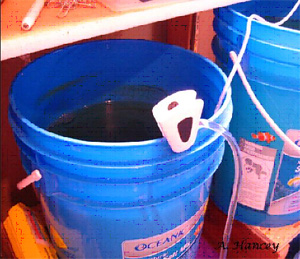
Syphoning from the bucket
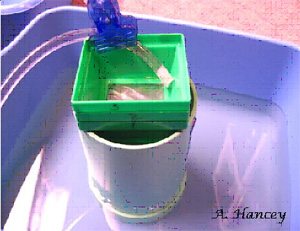
Water from the bucket is going through several sieves**. The water, in this case, is being collected in a dishpan purchased from the dollar store.
**I use several sieves while siphoning out my pods and they range from largest to smallest in mesh size. It is not necessary to do this, but here’s how my sieves are laid out. I’ve numbered the green sieves (I purchased mine from BrineShrimpDirect.com) as 1, 2 and 3 – 3 being the largest micron size, 1 being the smallest. The #3 sieve (560 microns) will collect any junk that is in the water that is larger than the pods themselves (including adult brine shrimp if you are raising them). The #2 sieve (300 microns) will collect adult copepods. The #1 sieve collects baby copepods and the big light green sieve that is in the picture is a 53 micron sieve that collects rotifers. (Refer to Appendix B for a more detailed explanation of sieve sizes.)
3) Flip the siphon with the rotifers/pods in it upside down over the new clean bucket that you set up in #1 and rinse the sieve with fresh saltwater.
Pouring water over the back of the sieve to get pods into the new bucket.
4) Add new phyto paste, stir it up a little to blend in the phyto and put the airline back in and you are done.
One Bucket Only Method
If you don’t have an extra bucket to work with, follow the following steps:
1) Get a small bowl that the sieves can easily fit in, and fill the bowl half way with new saltwater. Set aside.
2) Move your bucket to a location that is above the drain where you normally dispose of saltwater.
3) Let the bucket settle for at least 30 minutes.
4) siphon the rotifers/pods through a sieve as done in the previous section and out the drain.
5) Place your sieves into the shallow bowl you setup in step 1 to ensure that they remain under water while you clean the bucket.
6) Clean your bucket thoroughly
7) Add 1 gallon of fresh saltwater
8) Flip the siphon with the rotifers/pods in it upside down over the clean bucket and rinse the sieve with fresh saltwater.
9) Add new phyto paste, stir it up a little to blend in the phyto and put the airline back in and you are done.
Harvesting
Copepods - Getting copepods out of the container is about as simple as it gets. Take the appropriate sieve (usually 180 microns) and swipe it through the bucket and along the edges a couple times. Then rinse the pods with clean saltwater by holding the sieve over the bucket and pouring the clean water through the sieve. To add them to your tank, turn the sieve upside down over your tank and pour clean saltwater onto the back of the sieve. In order to avoid any cross contamination between your aquarium and the pods, never dip the sieve into your aquarium after it has been in the culture bucket. Once you have a healthy, strong culture of copepods growing, you should be able to harvest copepods at least every other day.
Rotifers – Rotifers are not as easy to harvest because I don’t have a small sieve to swipe through the bucket. (I really should make one.) I will take a clean quart-sized container or larger and fill it up with the rotifer water. Then hold a sieve over the rotifer bucket and pour the water through the sieve and back into the bucket. Rinse the rotifers that are in the sieve with clean saltwater before putting them into your tank. I usually just rinse them over the bucket so I am adding new saltwater to my bucket at the same time. I will add them to my tank the same way I added the pods, by turning the sieve upside down and pouring clean saltwater onto the back of the sieve - avoiding any cross contamination between my aquarium and the rotifers.
Please refer to Appendix B for important notes on enriching rotifers.
Things you may have noticed are missing
A heater – room temperature is fine. If rotifers are growing too slow, you can add a heater and set it to 75-80 and they will multiply faster. If you keep the heater on them however, you will need to make sure you do daily harvesting because they can multiply so fast that they will crash. Copepods like the cold. My copepod culture can get down to 58-60 in the winter and up to 65 in the summer. (I have them in the basement on a concrete floor.)
Glass – I have found that rotifers prefer plastic or fiberglass over glass. I tried growing rotifers for several years in 10 gallon containers and they kept crashing. Since I have moved to a plastic bucket over a year and a half ago, I haven’t had a rotifer or copepod crash.
Overhead Light – These critters hide when they are in our aquariums, and they come out at night. So they obviously like the night life better. I’ve had more success since I dimmed the lights out on them.
Creating a backup
It’s never a bad idea to have a backup in case you lose your culture. That way if you lose your main culture, you can start the culture over again with the backup pods/rotifers. I always have a 1 gallon bucket running with rotifers and copepods in them. (I just grow them together in this bucket.)
Pictured to the right is my one gallon white bucket. They grow very slow, which is what I want. I end up changing the water about every 3 months. I know, it’s crazy…but it works.
One Gallon Backup of Pods
|
There are a lot of different sieve sizes and they can be used for so many different purposes. That’s why it’s always hard for me to give a straight answer to anyone when they ask,” What sieve do you use?” Sieves sizes are measured in microns so you have to know what micron size the pods are that you are working with in order to know what sieve size you need. So what’s a micron? It’s a metric measurement that is .0001 of a centimeter. To give you an idea of size, a typical hair from your head is 100 microns.
First let me give you the basic sizes of the different critters you may be working with. Then, from that, you will need a sieve that is smaller than the size of what you are trying to catch. |
Pods working with Pod size Seive Sizein Microns

